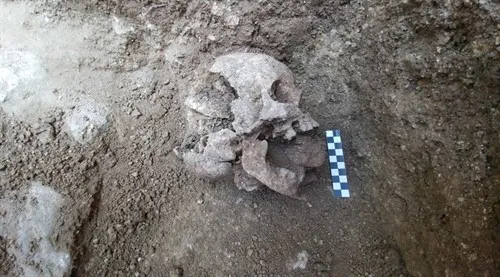
Archaeologists in Italy have discovered the remains of a child with a stone in his mouth in a 5th-century Italian cemetery.
They believe unusual discoveries are the result of people from the 5th century trying to prevent bodies from 'turning into zombies,' and spreading malaria.
Vampire Funeral?
The burial of a vampire or anti-vampire burial was a burial carried out in ancient times in a way that was thought to prevent the deceased from rising from death in the form of a vampire or to prevent the "real" vampire from appearing.
This tradition often appears in various medieval times.
Throughout Europe, experts have discovered a number of Vampire burials with the most common feature being a stone placed at the mouth of a corpse.
The skeletal remains, discovered by archaeologists from the University of Arizona and Stanford University, along with archaeologists from Italy, the rest of the skeleton is the subject of a burial ritual designed to prevent the spread of the disease from the body, experts explained.
The discovery of this unusual 'vampire burial' was carried out during the summer in the Lugnano commune in Teverina, in the Italian region of Umbria, where archaeologist David Soren of the University of Arizona has been monitoring archaeological excavations since 1987.
"I have never seen anything like this. This is very frightening and strange, "said Soren, a Bupati Professor at the UA Anthropology School and Department of Religion and Classical Studies.
Locally, they call it "Vampire of Lugnano."
Creepy ancient cemetery
According to Alexis Blue from Arizona University Communications, the burial of Vampires was found at La Necropoli dei Bambini, or in the Baby Cemetery, which began in the middle of the 5th century.
Experts believe that during the fifth century, outbreaks of deadly malaria swept through the region's human population, killing many vulnerable infants and young children.
The bodies of young victims were buried at the location of an abandoned Roman villa which was originally built in the late first century BC.
Experts excavating graves believe until now that that's where fifth-century people bury babies, toddlers and / or unborn fetuses.
In fact, previous excavations revealed more than 50 cemeteries where the remains of a three-year-old girl's skeleton were the oldest found.
However, what experts think they know about 'Necropoli dei Bambini' changes when they dig up the remains of a 10-year-old child.
"The discovery of a 10-year-old child, whose age is determined based on dental development but whose gender is unknown, suggests that graves may have been used for older children too," explained biologist Jordan Wilson.
Experts hope that the excavations at Bambini's Necropolidei will help them understand the devastating malaria epidemic that killed most of the population in Umbria about 1,500 years ago and to learn how communities face outbreaks.
Reference:
'Vampire Burial' Reveals to Prevent Child's Return from Grave. (n.d.) Retrieved October 21, 2018, from uanews.arizona.edu/story/vampire-burial-reveals-efforts-prevent-childs-return-grave